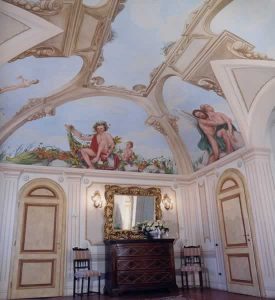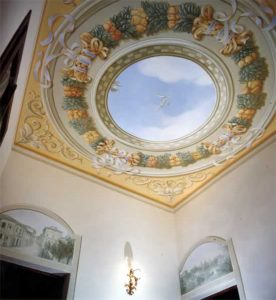Frescoes
Fresco is a mural painting technique in fresh applied coating made of sand and lime.
Pigment colours are simply diluted in clean water and applied on the wall, still wet, then fixed by the lime for fresco (often called “Hydrated lime).
Maurizio Magretti knew this tecnique during his artistic curriculum, attending the school of the Master Enrico fornaini.
Maurizio Magretti realizes the same frescoes like the Renaissance painters.
No mistake to a perfect fresco
The fresco painting is soaked up the painting coat: therefore, it is quite difficult to realize andit requires a really very quick performance. It is possible to paint until the fresh painting coat is able to absorb the damp brusk strokes of colour. The fresco is different from any other techniques of mural painting (trompe l’oeil, decorative painting, etc.), because, in case of mistake, instead of painting over it, it is necessary to do that part of the work once again, ex novo, by taking all the spoiled painting coat off, by spreading a new painting coat and starting the fresco the day after.
The fresco does not allow uncertainties and does not admits improvisations.
How one can perform a fresco
The fresco, the principal technique of mural paintings:
1. a first layerv of rough coating, usually called “arricciato”: Apèplied on the support, this mortal is a mixture of hydrated lime (calceium hydroxide) and coarse sand
2. the second layer, the painting coat consists of hydrates lime and well-fiftered fine sand
3. the third layer is the pictorial layer made of pigments and pure water applied in several coatings with a brush
4. the calcified layer results from the carbonatipon of the lime mortar which, while drying, produces a transparent protective crust. The pellicle includes the pigments and fixed them definitively.
There are many Architects, on behalf of several Dioceses or Churches in Italy, who demand fresco paintings in order to realize traditional Biblical Images, concerning themes from Old and New Testament.
Even hotels, residences and historical villas, which need to be restored, require fresco paintings in order to increase or preserve the artistic value of their habitats.
Also…
You can download the catalog constantly updated or read the artistic curriculum, the techniques used in frescoes, decorative painting, trompe l’oeil and art.




